Crew Dragon landing and asteroid video shot
Photos of space events in good quality usually do not appear immediately. What about the ISS, what is from the interplanetary station, they must be transmitted and processed. Therefore, the docking of Crew Dragon had to be illustrated with low-quality Internet broadcast frames. And now, as a kind of semantic completion of my two previous materials, I will talk about the landing of the Crew Dragon, as well as we will see the high-quality photos of the ship’s flight and the video of the shot at the asteroid of the Japanese probe Hayabusa-2 released last week.
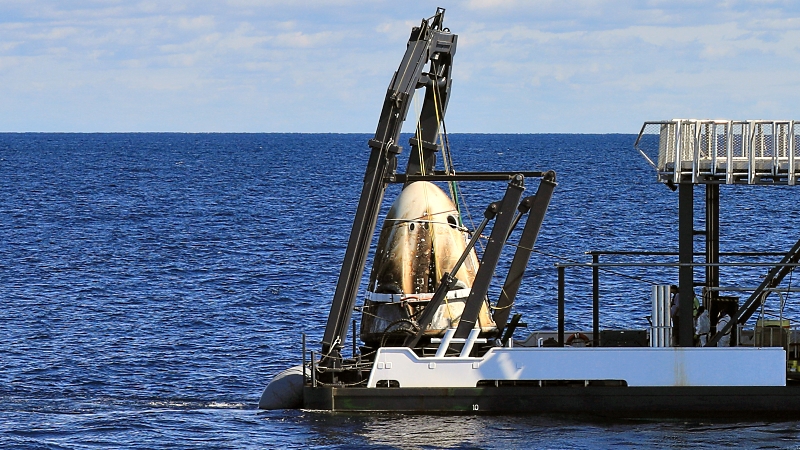
Crew Dragon, raised after successfully landing on the deck of the GO Searcher. NASA Photos
A symbolic comparison with the new era of space flights was the approach of Crew Dragon to the ISS against the backdrop of the rising sun.
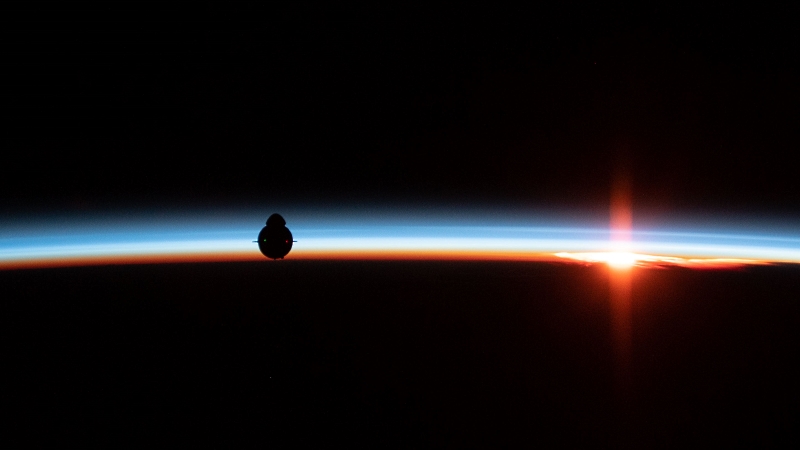
Full size
As the ship approached, the station crew took some photos.

Full size
If it weren’t for the part of the Canadarm2 manipulator that got into the frame, an almost perfect photo would be obtained. The extended docking unit and brake orientation motors are clearly distinguishable.
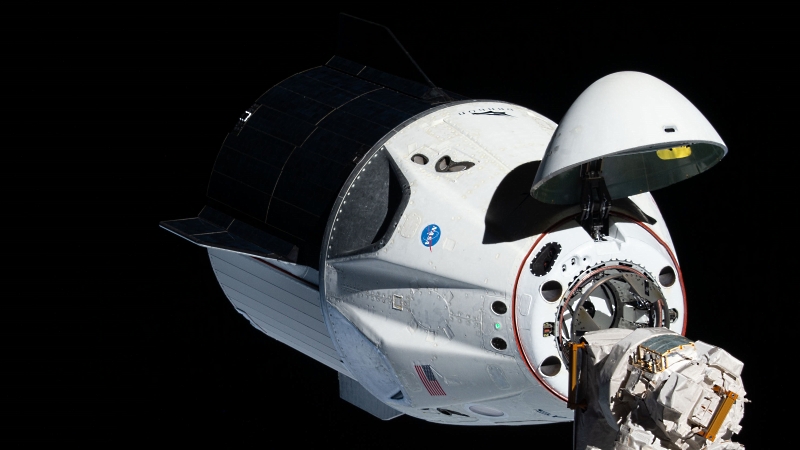
Full size
During the five days of the ship’s stay on the ISS, the station’s crew unloaded 181 kg of supplies, placed 136 kg of cargo that needed to be returned to the ground and, together with the MCC, monitored the status of Crew Dragon. Shortly before undocking, the astronauts and astronauts looked into the ship for the last time, took pictures and closed the hatches at 20:39 Moscow time on March 7.
Undocking occurred at 10:32 Moscow time. It is curious that another technique was used - “Unions”, “Progress” and the shuttles were repelled by springs in the docking station and moved a certain distance before turning on the engines. This was done to ensure the cleanliness of the docking station. The Crew Dragon has a different design, so the ship gave an impulse lasting 1.5 seconds and began to move away from the station at a speed of 0.15 m / s. After a few seconds, another same impulse was issued, and after 40 seconds a longer impulse of departure (departure burn), which increased the speed of divergence to 0.65 m / s.
The second departure pulse brought the divergence rate to 1.25 m / s. Then the ship turned around and after 53 minutes spent the third maneuver of departure, and after 1 hour 39 minutes - the fourth. After five hours of free flight, Crew Dragon embarked on a landing operation. The service compartment with solar panels was reset at 15:48 Moscow time, the ship switched to battery power. At 15:53, a fifteen-minute braking maneuver began. The landing area was in the Atlantic Ocean, northeast of the coast of Florida.

A source
At 16:33 Crew Dragon passed a height of 121 km, and this was the beginning of braking in the atmosphere. Just seven minutes later, at 16:40, the ship completed this stage and proceeded to the last landing operations. Two brake parachutes opened at 16:41, and the four main ones at 16:42. And at about 16:45 the ship successfully splashed down.
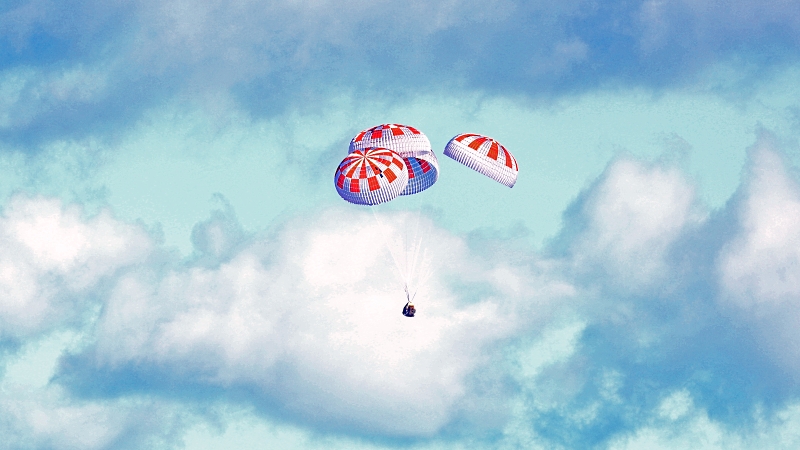
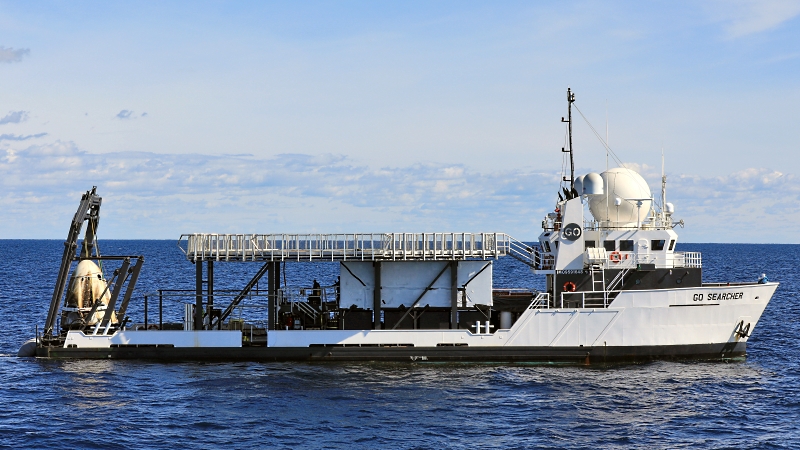
Dragon Crew parachuting aboard the GO Searcher.
This ship is waiting for another test. It will be used in testing the emergency rescue system. The ship starts on the Falcon 9 with the usual first stage and the layout of the second, and at about sixtieth second the CAC Super Draco engines will be activated. It is expected that the step will not survive this test, but when a similar test was performed on the New Shepard suborbital carrier, its step survived the departure of the ship and was able to make a soft landing.
Despite the fact that the flight of Crew Dragon as a whole was successful, it certainly revealed minor flaws. Therefore, many publications suggest that the manned mission DM-2 will move from July to a later date and call the launch date “realistic until the end of 2019” more realistic.
In the article before last, I talked about how the Japanese Hayabusa-2 probe touched the asteroid Ryugu and shot a tantalum “bullet” at it. At the beginning of last week, the Japanese space agency published a video from the frames shot by the camera of the device during the decline, shot and rise.

Completely.
Now the probe, by the way, does not lose time in vain. On March 7, Hayabusa-2 made a descent to 22 meters above the S01 area, in which they plan to shoot a shell in April to create a crater. But the last, second tantalum bullet may not be used.

S01 area on asteroid map, image JAXA

Crew Dragon, raised after successfully landing on the deck of the GO Searcher. NASA Photos
Arrival
A symbolic comparison with the new era of space flights was the approach of Crew Dragon to the ISS against the backdrop of the rising sun.

Full size
As the ship approached, the station crew took some photos.

Full size
If it weren’t for the part of the Canadarm2 manipulator that got into the frame, an almost perfect photo would be obtained. The extended docking unit and brake orientation motors are clearly distinguishable.

Full size
Undocking and landing
During the five days of the ship’s stay on the ISS, the station’s crew unloaded 181 kg of supplies, placed 136 kg of cargo that needed to be returned to the ground and, together with the MCC, monitored the status of Crew Dragon. Shortly before undocking, the astronauts and astronauts looked into the ship for the last time, took pictures and closed the hatches at 20:39 Moscow time on March 7.
Undocking occurred at 10:32 Moscow time. It is curious that another technique was used - “Unions”, “Progress” and the shuttles were repelled by springs in the docking station and moved a certain distance before turning on the engines. This was done to ensure the cleanliness of the docking station. The Crew Dragon has a different design, so the ship gave an impulse lasting 1.5 seconds and began to move away from the station at a speed of 0.15 m / s. After a few seconds, another same impulse was issued, and after 40 seconds a longer impulse of departure (departure burn), which increased the speed of divergence to 0.65 m / s.
The second departure pulse brought the divergence rate to 1.25 m / s. Then the ship turned around and after 53 minutes spent the third maneuver of departure, and after 1 hour 39 minutes - the fourth. After five hours of free flight, Crew Dragon embarked on a landing operation. The service compartment with solar panels was reset at 15:48 Moscow time, the ship switched to battery power. At 15:53, a fifteen-minute braking maneuver began. The landing area was in the Atlantic Ocean, northeast of the coast of Florida.

A source
At 16:33 Crew Dragon passed a height of 121 km, and this was the beginning of braking in the atmosphere. Just seven minutes later, at 16:40, the ship completed this stage and proceeded to the last landing operations. Two brake parachutes opened at 16:41, and the four main ones at 16:42. And at about 16:45 the ship successfully splashed down.


Dragon Crew parachuting aboard the GO Searcher.
This ship is waiting for another test. It will be used in testing the emergency rescue system. The ship starts on the Falcon 9 with the usual first stage and the layout of the second, and at about sixtieth second the CAC Super Draco engines will be activated. It is expected that the step will not survive this test, but when a similar test was performed on the New Shepard suborbital carrier, its step survived the departure of the ship and was able to make a soft landing.
Despite the fact that the flight of Crew Dragon as a whole was successful, it certainly revealed minor flaws. Therefore, many publications suggest that the manned mission DM-2 will move from July to a later date and call the launch date “realistic until the end of 2019” more realistic.
Fired back
In the article before last, I talked about how the Japanese Hayabusa-2 probe touched the asteroid Ryugu and shot a tantalum “bullet” at it. At the beginning of last week, the Japanese space agency published a video from the frames shot by the camera of the device during the decline, shot and rise.

Completely.
Now the probe, by the way, does not lose time in vain. On March 7, Hayabusa-2 made a descent to 22 meters above the S01 area, in which they plan to shoot a shell in April to create a crater. But the last, second tantalum bullet may not be used.

S01 area on asteroid map, image JAXA
